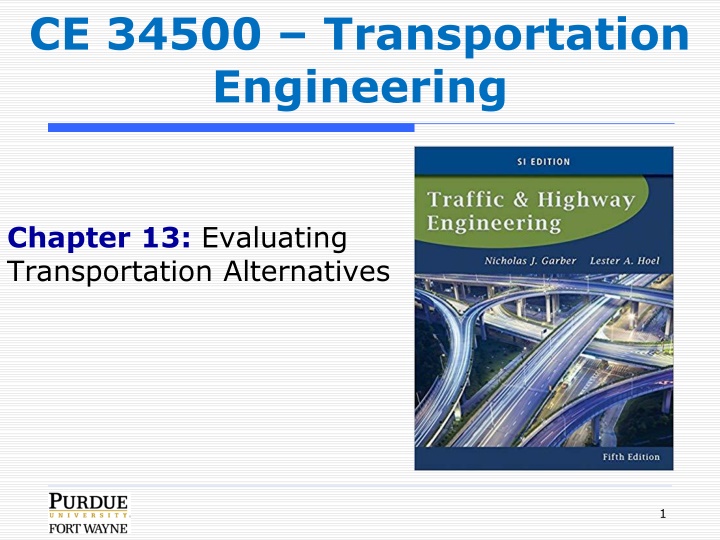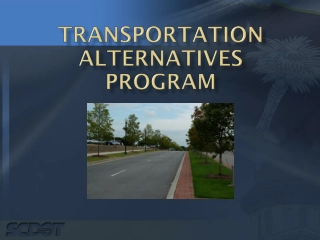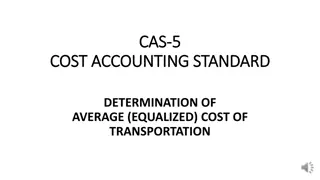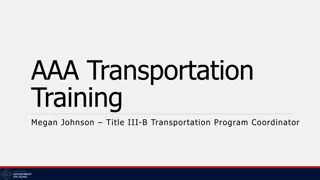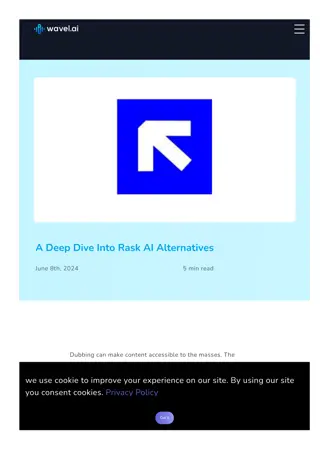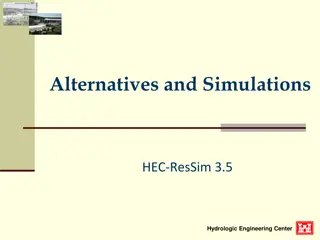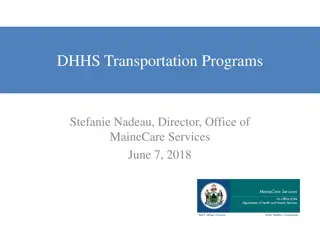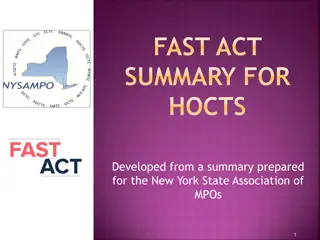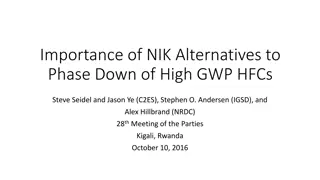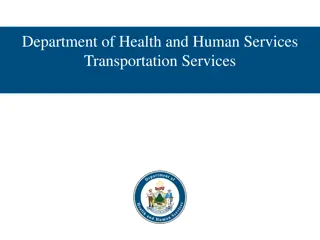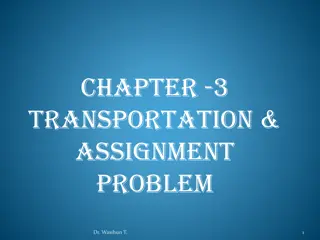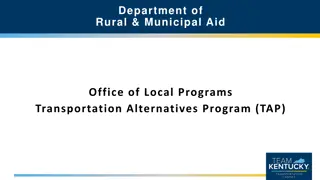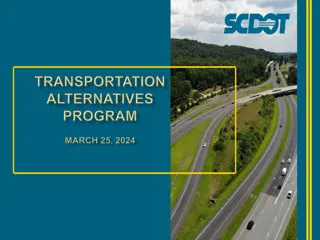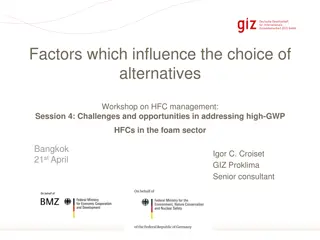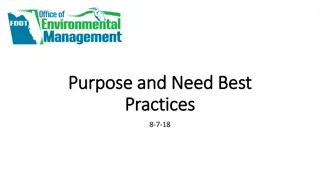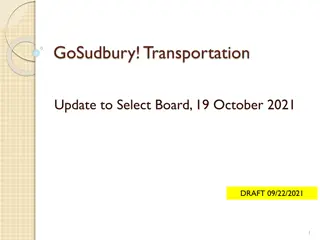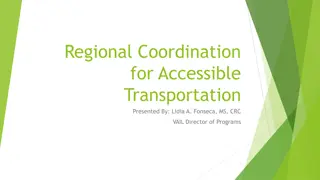Evaluating Transportation Alternatives in Engineering
Within transportation engineering, evaluating alternatives is crucial for decision-making. Proposals are essential in proposing solutions to existing issues, such as improving safety at railroad crossings. Major components in a proposal include transportation alternatives under budget constraints. The objective of evaluation is to provide necessary information for selecting the best alternative based on criteria like costs, benefits, travel time, and safety. Measures of effectiveness involve converting measures into common units and numerical scores for economic and multiple criteria evaluations.
Download Presentation

Please find below an Image/Link to download the presentation.
The content on the website is provided AS IS for your information and personal use only. It may not be sold, licensed, or shared on other websites without obtaining consent from the author.If you encounter any issues during the download, it is possible that the publisher has removed the file from their server.
You are allowed to download the files provided on this website for personal or commercial use, subject to the condition that they are used lawfully. All files are the property of their respective owners.
The content on the website is provided AS IS for your information and personal use only. It may not be sold, licensed, or shared on other websites without obtaining consent from the author.
E N D
Presentation Transcript
CE 34500 Transportation Engineering Chapter 13: Evaluating Transportation Alternatives 1
Example: Rail Road Crossing Improve safety at a railroad crossing based on citizen complaints about crashes. Source: https://safety.fhwa.dot.gov/hsip/xings/com_roaduser /07010/sec04b.cfm 2
Definition of Proposal A proposal is a description of the work you will complete on a project. The details included in a proposal depend on the project's scope and who will read the document. Typically, organizations advertise a need for proposals and consulting engineers respond to the need. However, as an engineer, you may determine that a problem exists, and therefore, propose solutions to an organization. In this case, you must first convince the agency that the problem exists before proposing your solutions. - Colorado State University, https://writing.colostate.edu/guides/guide.cfm?guideid=81 3
Major components in Proposal Transportation alternatives under budget. Alternative 1: Install gates and flashing lights. Alternative 2: Construct a grade separated overpass 4
Objective of Evaluation Furnish the appropriate information about the outcome of each alternatives so that a selection can be made. Select best alternative 5
Selecting and measuring evaluation criteria Common Criteria: Costs Construction costs Maintenance costs Operating costs Social and environmental costs Benefits 1. Travel time 2. Safety 1. 2. 3. 4. 6
Measures of Effectiveness Converting each measure to common unit (e.g. $$$) Converting each measure to numerical score Alt 1 Alt 2 Alt 3 Alt 4 Alt 5 $$$, BCR 1.5 1.12 1.18 0.74 0.8 Numerical Score 87.5 87.2 74.5 77 79 1. Evaluation based on Economic Criteria 2. Evaluation based on Multiple Criteria 7
Measures of Effectiveness Converting each measure to common unit (e.g. $$$) Common Criteria: Costs Calculate benefits Calculate Costs Calculate Benefit- to-Cost Ratio (BCR) Construction costs Maintenance costs Operating costs Social and environmental costs Benefits 1. Travel time 2. Safety 1. 2. 3. 4. 8
In-class Problem A state DOT is considering three alternatives for improvement of a particular urban facility. The objectives are to improve travel speeds, increase safety and reduce operating costs for users. The annual dollar values of savings, as well as additional construction and maintenance costs for each alternative compare to Do- Nothing (DN) are given in the following table. If N = 50 years and I = 3%, determine the best alternative. Annual additional maintenance costs $1,500 Annual savings in crash costs Annual operating savings Construction cost Annual travel time benefits Alt I $185,000 $5,000 $3,000 $500 II $220,000 $5,000 $6,500 $500 $2,500 III $310,000 $7,000 $6,000 $2,800 $3,000 9
Net Present Worth 1 + ?? 1 ? 1 + ?? ???1= ? Years Annual costs 10
Evaluation Based on Multiple Criteria Rating & ranking Assigning numerical scores to different criteria ? ??= ????? ?=1 N number of criteria used in evaluation Si total value of score of alternative i Kj weight placed on criterion j Vij relative value achieved by criterion j for alternative i ?? ?? ?=1 ??= ? Wj relative weight for criterion j 11
In-class Problem A transit agency is evaluating alternatives for a light rail line construction. Five alternatives are evaluated for five different criteria. Evaluate the alternatives using the rating and ranking method. No 1 2 3 4 5 Criterion (MOE) Alt 1 25 13 8 25 3.5 Alt 2 23 14 7 35 3 Alt 3 20 11 6 40 2 Alt 4 18 13.5 5 50 1.5 Alt 5 17 15 5 50 1.5 Daily ridership (1000s) Annual return on investment (%) Length of line (mi) Passengers seated in peak hour (%) Auto drivers diverted (1000s) 12
Point Score for Each Alternative out of 100 Ranking 1 2 3 3 4 1 2 3 4 5 Annual Return on Investment Daily Ridership Passengers seated in peak hour Length on line Auto Drivers diverted Alt 1 Alt 2 Alt 3 Alt 4 Alt 5 Numerical Score 87.5 87.2 74.5 77 79 13
Point Score for Candidate Transit Lines Alternatives III Measure of Effectiveness I II IV V 1 2 3 4 5 Total 26 24 8.5 17 12 87.5 87.2 74.5 77 79 14
